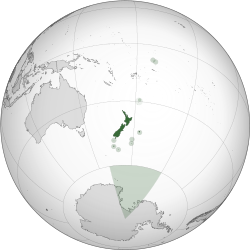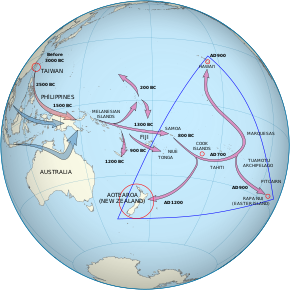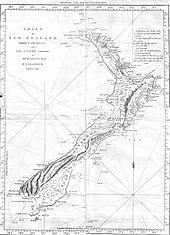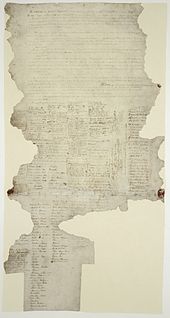Wednesday, July 7, 2021
Tuesday, July 6, 2021
Saturday, December 14, 2019
New Zealand
New Zealand
"NZ" redirects here. For other uses, see NZ (disambiguation) and New Zealand (disambiguation).
New Zealand
Aotearoa (Māori)
| |
|---|---|

Location of New Zealand, including outlying islands, its territorial claim in the Antarctic, and Tokelau
| |
| Capital | Wellington 41°18′S 174°47′E 41°18′S 174°47′E |
| Largest city | Auckland |
| Official languages | |
| Ethnic groups
(2018)
| |
| Demonym(s) | New Zealander Kiwi (informal) |
| Government | Unitary parliamentary constitutional monarchy |
• Monarch
| Elizabeth II |
| Patsy Reddy | |
| Jacinda Ardern | |
| Legislature | Parliament (House of Representatives) |
| Stages of independence
from the United Kingdom
| |
| 7 May 1856 | |
• Dominion
| 26 September 1907 |
25 November 1947 | |
| Area | |
• Total
| 268,021 km2 (103,483 sq mi) (75th) |
• Water (%)
| 1.6[n 4] |
| Population | |
• December 2019 estimate
| 4,947,580[5] (120th) |
• 2018 census
| 4,699,755 |
• Density
| 18.1/km2 (46.9/sq mi) (203rd) |
| GDP (PPP) | 2018 estimate |
• Total
| $199 billion[6] |
• Per capita
| $40,266[6] |
| GDP (nominal) | 2018 estimate |
• Total
| $206 billion[6] |
• Per capita
| $41,616[6] |
| Gini (2014) | 33.0[7] medium · 22nd |
| HDI (2018) | very high · 14th |
| Currency | New Zealand dollar ($) (NZD) |
| Time zone | UTC+12 (NZST[n 5]) |
• Summer (DST)
| UTC+13 (NZDT[n 6]) |
| Date format | dd/mm/yyyy yyyy-mm-dd[10] |
| Driving side | left |
| Calling code | +64 |
| ISO 3166 code | NZ |
| Internet TLD | .nz |
New Zealand (Māori: Aotearoa [aɔˈtɛaɾɔa]) is a sovereign island country in the southwestern Pacific Ocean. The country has two main landmasses—the North Island (Te Ika-a-Māui), and the South Island (Te Waipounamu)—and around 600 smaller islands. It has a total land area of 268,000 square kilometres (103,500 sq mi). New Zealand is about 2,000 kilometres (1,200 mi) east of Australia across the Tasman Sea and 1,000 kilometres (600 mi) south of the Pacific island areas of New Caledonia, Fiji, and Tonga. Because of its remoteness, it was one of the last lands to be settled by humans. During its long period of isolation, New Zealand developed a distinct biodiversity of animal, fungal, and plant life. The country's varied topography and its sharp mountain peaks, such as the Southern Alps, owe much to the tectonic uplift of land and volcanic eruptions. New Zealand's capital city is Wellington, and its most populous city is Auckland.
Sometime between 1250 and 1300, Polynesians settled in the islands and developed a distinctive Māori culture. In 1642, Dutch explorer Abel Tasman became the first European to sight New Zealand. In 1840, representatives of the United Kingdom and Māori chiefs signed the Treaty of Waitangi, which declared British sovereignty over the islands. In 1841, New Zealand became a colony within the British Empire and in 1907 it became a dominion; it gained full statutory independence in 1947 and the British monarch remained the head of state. Today, the majority of New Zealand's population of 4.9 million is of European descent; the indigenous Māori are the largest minority, followed by Asians and Pacific Islanders. Reflecting this, New Zealand's culture is mainly derived from Māori and early British settlers, with recent broadening arising from increased immigration. The official languages are English, Māori, and New Zealand Sign Language, with English being very dominant.
A developed country, New Zealand ranks highly in international comparisons of national performance, such as quality of life, health, education, protection of civil liberties, and economic freedom. New Zealand underwent major economic changes during the 1980s, which transformed it from a protectionist to a liberalised free-trade economy. The service sector dominates the national economy, followed by the industrial sector, and agriculture; international tourism is a significant source of revenue. Nationally, legislative authority is vested in an elected, unicameral Parliament, while executive political power is exercised by the Cabinet, led by the prime minister, currently Jacinda Ardern. Queen Elizabeth II is the country's monarch and is represented by a governor-general, currently Dame Patsy Reddy. In addition, New Zealand is organised into 11 regional councils and 67 territorial authorities for local government purposes. The Realm of New Zealand also includes Tokelau (a dependent territory); the Cook Islands and Niue (self-governing states in free association with New Zealand); and the Ross Dependency, which is New Zealand's territorial claim in Antarctica. New Zealand is a member of the United Nations, Commonwealth of Nations, ANZUS, Organisation for Economic Co-operation and Development, ASEAN Plus Six, Asia-Pacific Economic Cooperation, the Pacific Community and the Pacific Islands Forum.
Etymology
See also: New Zealand place names
Dutch explorer Abel Tasman sighted New Zealand in 1642 and named it Staten Land "in honour of the States General" (Dutch parliament). He wrote, "it is possible that this land joins to the Staten Land but it is uncertain",[11] referring to a landmass of the same name at the southern tip of South America, discovered by Jacob Le Maire in 1616.[12][13] In 1645, Dutch cartographers renamed the land Nova Zeelandia after the Dutch province of Zeeland.[14][15] British explorer James Cook subsequently anglicised the name to New Zealand.[16]
Aotearoa (pronounced /ˌaʊtɛəˈroʊ.ə/; often translated as "land of the long white cloud")[17] is the current Māori name for New Zealand. It is unknown whether Māori had a name for the whole country before the arrival of Europeans, with Aotearoa originally referring to just the North Island.[18] Māori had several traditional names for the two main islands, including Te Ika-a-Māui (the fish of Māui) for the North Island and Te Waipounamu (the waters of greenstone) or Te Waka o Aoraki (the canoe of Aoraki) for the South Island.[19] Early European maps labelled the islands North (North Island), Middle (South Island) and South (Stewart Island / Rakiura).[20] In 1830, mapmakers began to use "North" and "South" on their maps to distinguish the two largest islands and by 1907 this was the accepted norm.[16] The New Zealand Geographic Board discovered in 2009 that the names of the North Island and South Island had never been formalised, and names and alternative names were formalised in 2013. This set the names as North Island or Te Ika-a-Māui, and South Island or Te Waipounamu.[21] For each island, either its English or Māori name can be used, or both can be used together.[21]
History
Main article: History of New Zealand

The Māori people are most likely descended from people who emigrated from Taiwan to Melanesia and then travelled east through to the Society Islands. After a pause of 70 to 265 years, a new wave of exploration led to the discovery and settlement of New Zealand.[22]
New Zealand was one of the last major landmasses settled by humans. Radiocarbon dating, evidence of deforestation[23] and mitochondrial DNA variability within Māori populations[24] suggest New Zealand was first settled by Eastern Polynesians between 1250 and 1300,[19][25] concluding a long series of voyages through the southern Pacific islands.[26] Over the centuries that followed, these settlers developed a distinct culture now known as Māori. The population was divided into iwi (tribes) and hapū (subtribes) who would sometimes cooperate, sometimes compete and sometimes fight against each other.[27] At some point a group of Māori migrated to Rēkohu, now known as the Chatham Islands, where they developed their distinct Moriori culture.[28][29] The Moriori population was all but wiped out between 1835 and 1862, largely because of Taranaki Māori invasion and enslavement in the 1830s, although European diseases also contributed. In 1862 only 101 survived, and the last known full-blooded Moriori died in 1933.[30]

Map of the New Zealand coastline as Cook charted it on his first visit in 1769–70. The track of the Endeavour is also shown.
The first Europeans known to have reached New Zealand were Dutch explorer Abel Tasman and his crew in 1642.[31] In a hostile encounter, four crew members were killed and at least one Māori was hit by canister shot.[32] Europeans did not revisit New Zealand until 1769 when British explorer James Cook mapped almost the entire coastline.[31] Following Cook, New Zealand was visited by numerous European and North American whaling, sealing and trading ships. They traded European food, metal tools, weapons and other goods for timber, Māori food, artefacts and water.[33] The introduction of the potato and the musket transformed Māori agriculture and warfare. Potatoes provided a reliable food surplus, which enabled longer and more sustained military campaigns.[34] The resulting intertribal Musket Wars encompassed over 600 battles between 1801 and 1840, killing 30,000–40,000 Māori.[35] From the early 19th century, Christian missionaries began to settle New Zealand, eventually converting most of the Māori population.[36] The Māori population declined to around 40% of its pre-contact level during the 19th century; introduced diseases were the major factor.[37]

The Waitangi sheet from the Treaty of Waitangi
In 1788 Captain Arthur Phillip assumed the position of Governor of the new British colony of New South Wales which according to his commission included New Zealand.[38] The British Government appointed James Busby as British Resident to New Zealand in 1832 following a petition from northern Māori.[39] In 1835, following an announcement of impending French settlement by Charles de Thierry, the nebulous United Tribes of New Zealand sent a Declaration of Independence to King William IV of the United Kingdom asking for protection.[39] Ongoing unrest, the proposed settlement of New Zealand by the New Zealand Company (which had already sent its first ship of surveyors to buy land from Māori) and the dubious legal standing of the Declaration of Independence prompted the Colonial Office to send Captain William Hobson to claim sovereignty for the United Kingdom and negotiate a treaty with the Māori.[40] The Treaty of Waitangi was first signed in the Bay of Islands on 6 February 1840.[41] In response to the New Zealand Company's attempts to establish an independent settlement in Wellington[42] and French settlers purchasing land in Akaroa,[43] Hobson declared British sovereignty over all of New Zealand on 21 May 1840, even though copies of the Treaty were still circulating throughout the country for Māori to sign.[44] With the signing of the Treaty and declaration of sovereignty the number of immigrants, particularly from the United Kingdom, began to increase.[45]

A meeting of European and Māori inhabitants of Hawke's Bay Province. Engraving, 1863.
New Zealand, still part of the colony of New South Wales, became a separate Colony of New Zealand on 1 July 1841.[46] Armed conflict began between the Colonial government and Māori in 1843 with the Wairau Affray over land and disagreements over sovereignty. These conflicts, mainly in the North Island, saw thousands of Imperial troops and the Royal Navy come to New Zealand and became known as the New Zealand Wars. Following these armed conflicts, large amounts of Māori land was confiscated by the government to meet settler demands.[47]
The colony gained a representative government in 1852 and the first Parliament met in 1854.[48] In 1856 the colony effectively became self-governing, gaining responsibility over all domestic matters other than native policy.[48] (Control over native policy was granted in the mid-1860s.[48]) Following concerns that the South Island might form a separate colony, premier Alfred Domett moved a resolution to transfer the capital from Auckland to a locality near Cook Strait.[49] Wellington was chosen for its central location, with Parliament officially sitting there for the first time in 1865.[50]
In 1891 the Liberal Party came to power as the first organised political party.[51] The Liberal Government, led by Richard Seddon for most of its period in office,[52] passed many important social and economic measures. In 1893 New Zealand was the first nation in the world to grant all women the right to vote[51] and in 1894 pioneered the adoption of compulsory arbitration between employers and unions.[53]
In 1907, at the request of the New Zealand Parliament, King Edward VII proclaimed New Zealand a Dominion within the British Empire,[54] reflecting its self-governing status.[55] In 1947 the country adopted the Statute of Westminster, confirming that the British Parliament could no longer legislate for New Zealand without the consent of New Zealand.[48]
Early in the 20th century, New Zealand was involved in world affairs, fighting in the First and Second World Wars[56] and suffering through the Great Depression.[57] The depression led to the election of the First Labour Government and the establishment of a comprehensive welfare state and a protectionist economy.[58] New Zealand experienced increasing prosperity following the Second World War[59] and Māori began to leave their traditional rural life and move to the cities in search of work.[60] A Māori protest movement developed, which criticised Eurocentrism and worked for greater recognition of Māori culture and of the Treaty of Waitangi.[61] In 1975, a Waitangi Tribunal was set up to investigate alleged breaches of the Treaty, and it was enabled to investigate historic grievances in 1985.[41] The government has negotiated settlements of these grievances with many iwi,[62] although Māori claims to the foreshore and seabed have proved controversial in the 2000s.[63][64]
Subscribe to:
Posts (Atom)










